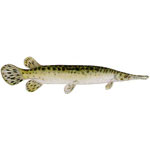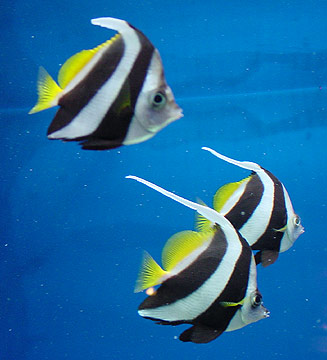Spotted Garfish

|
Scientific Name: Lepisosteus oculatus Price: Upon Request Origin: North America (from southern Ontario to the Gulf Coast) Family: Lepisosteidae NOT AVAILABLE NOW |
|
Other Names: Spotted gar, Lepisosteus oculatus |
|
Technical Info
Temperature: 15 - 23 ℃
pH: 6.5 - 8
GH: 9 - 19
Max size: 150 cm
Min Tank size: 1500 Ltr
Position in Aqua: No special swimming level
Description
Spotted Garfish are long and cylindrical with elongated mouths. Their upper body is brown to olive, and they have silver-white sides. Head, body, and fins have olive-brown to black spots that help camouflage the fish. A broad, dark stripe is on the sides of immature fish. Their long, snout-like mouth is lined with strong, sharp teeth, and their body is covered with thick, ganoid (diamond-shaped) scales. Spotted gar may be distinguished from other Texas gar species by the dark roundish spots on the top of the head, the pectoral fins and on the pelvic fins.
Food
It can sometimes be tricky to get newly-purchased fish to accept dead foods. Most will learn to do following a short period of starvation. If your fish is refusing to accept frozen foods, refrain from feeding for a few days then try again. After a short time you should find the fish will eat most meaty frozen foods such as prawns, lance fish etc. Larger specimens can be fed whole white fish, such as trout or sprats. Feed every day when juvenile but as the fish grows reduce the frequency. An adult specimen needs only one or two meals per week at most.
Breeding
Occasional aquarium spawnings have occured, but few details are available. Itís a seasonal spawner in nature, mating between the months of May and July. Eggs are simply scattered among aquatic vegetation, and no parental care is exhibited. Itís very fecund and up to 20,000 eggs may be deposited in a single spawning event.
Compatible with
Despite its fearsome reputation, this is actually quite a timid fish. While it wonít hesitate to munch any smaller tankmates, it can be kept alongside other big, peaceful species in suitable surroundings. Very active, aggressive or boisterous species should be avoided. Itís equally mellow with members of its own species and can usually be kept in a group provided all the fish are of a similar size.
Note
A large gar can eat a lot of fish, including catfish, causing them to compete with some anglers. Because of the competition and because many people think gar are difficult to clean, gar are sometimes called a "trash" fish. This term may not be warranted when you consider that spotted gar, like all native species, have an important role to play in their ecosystem.

